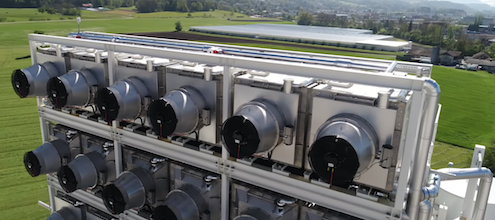
Without climate policy, “innovation” is just a buzzword
Lately we’ve seen argument after argument after argument for using “technology” and “innovation” as fixes for climate change. But reducing greenhouse gas emissions requires specific types of innovation. Without broad incentives that signal the value of low- or zero-carbon technologies, we’ll get more of what led us to this point. Ironically, carbon pricing opponents are emphasizing innovation when the best innovation policy is carbon pricing.
Innovation is a firehose
Finding new, better, or lower-cost ways to do things is intrinsic to our economic system. It’s the essence of competition. It’s dynamic and occurs at all times in every sector. Firms have strong financial incentives to develop new technologies or processes that work better, cost less, or deliver something different.
Innovation is generally beneficial on net. Learning to unlock the explosive power of fossil fuels, for example, has facilitated tremendous advances in human welfare. But innovation can also generate unintended consequences. Burning those fossil fuels in a very short timeframe has already warmed our planet by over 1°C, with additional increases already locked in.
Innovation is a firehose—powerful, hard to aim, occasionally prone to recoil. To slow (or reverse) climate change, we must ensure the hose is pointed in the right direction: toward low-carbon, zero-carbon, and carbon-negative technologies.
We need better aim
Equally important, we need to signal our preference for low-carbon innovation over high-carbon innovation. The eternal quest for efficiency already guides some low-carbon investment. But there is still plenty of labour, capital, and resources devoted to finding better or feasible ways to produce or use high-carbon products. For example, would firms continue investing in ways to make Arctic drilling cheaper if the climate impacts were baked into their project costs?
Creating widespread incentives for low-carbon technologies and accounting for the hidden costs of high-carbon innovation takes more than tech funds or promises of industry partnerships. Without policy and technical assistance, innovation won’t get us there fast enough on its own. If markets are free to ignore the costs of warming, they will overproduce the products that cause it.
Innovation and technology have led us to where we are
Innovation and technology have largely ignored climate impacts to this point, putting us on a path for a potentially catastrophic 4°C increase in average global temperatures. Policy is catching up to this reality, and there is clarity on which policies best foster low-carbon innovation. As a 2016 study from David Popp notes:
“[C]ombining both R&D subsidies and carbon prices yields the largest economic benefit, a policy using only the carbon tax achieves 95 percent of the benefits of the combined policy… using only a R&D subsidy attains just 11 percent of the benefits of the combined policy.”
In other words, there’s a solid rationale for public investments in R&D, but certainly not in place of broad-based price signals. Optimally, they should work together. Non-Canadian studies have replicated this finding as well.
The cost of waiting
The promise of innovation in the future is not a substitute for reducing emissions in the present. A comprehensive meta-analysis found that delaying serious policy action by one decade increases the overall costs of climate change by 40 percent. Delay means ramping up harder and faster to make up for lost time.
The idea that we can delay and simply innovate our way out from under climate change is evidence-free hand waving at best. Moreover, advocating for “technology” instead of stringent policy downplays the very real risk that additional warming will cause irreversible damage. Insurance rates will inevitably climb higher and stay there. Children stunted by poor nutrition cannot be un-stunted. Flooded coastlines cannot be unflooded. Thawed permafrost cannot be refrozen. Species that go extinct cannot go un-extinct.
Innovation doesn’t excuse policy inaction
Innovation and technology are a healthy part of the climate discussion. Both are essential for decarbonization. But leaving markets to their own devices without correcting their fundamental shortcomings will not get us there fast enough. Policies that work best to drive low-carbon innovation are stringent, flexible, and offer long-term certainty. A good carbon pricing policy checks every box.
Innovation and technology are vital cogs in our economic engine and our best hope for responding to the threat of climate change. But unless they’re backed by policy, they’re just buzzwords.




4 comments
Innovative fuel efficient internal combustion engine vehicles resulted in more SUVs and pickups in the fleet, driving further, negating much of the gains. So yes innovation alone can’t do it. I like to think of PUSH and PULL. Innovation can push, and carbon pricing can pull. They don’t conflict. So if you have a brilliant idea for how to decarbonize using technology, that technology will be pulled onto the market sooner / faster with a stringent carbon price. And as we decarbonize, in a fossil fuel rich country like Canada, the costs of fossil fuels may decline to weak demand, encouraging more consumption. A ratcheting carbon price helps maintain incentive to abate. The 2007 book “Cool It” by Bjorn Lomborg proposed doing R&D instead of panicking and doing something. A decade later we’re out of runway. Time to panic and do something. Time to start PULLing R&D onto the market with carbon pricing.
In any case, while innovation is generally good, we don’t actually need it right now. It’s already happened. Wind and solar technologies have gotten so cheap that they are now the cheapest source of power. All we have to do is install ’em. Even if somehow no further innovations happened in the course of ramping up production and installation, we have what we need. Similarly, technologies have already been innovated to make buildings zero-carbon, to produce concrete that absorbs CO2 rather than emitting it, to make solidly workable electric cars and most other transportation. We can do the transition now.
If we really want innovation, the best way to foster further innovation in these things is to produce lots of them.
Hi PLG,
Thanks for the comment. You are correct, many of the solutions are out there and a lot of them are already scaleable. There are incremental improvements that can still help in the meantime–lighter materials, more efficient manufacturing, longer lifespans, etc. We also shouldn’t close ourselves off to the possibility that a better, cheaper source of energy comes along.
Thanks for reading!
The best reason for the use of Carbon Pricing is to change our mindset and force ourselves to be more wise about how we use energy…Think Smart!
Comments are closed.